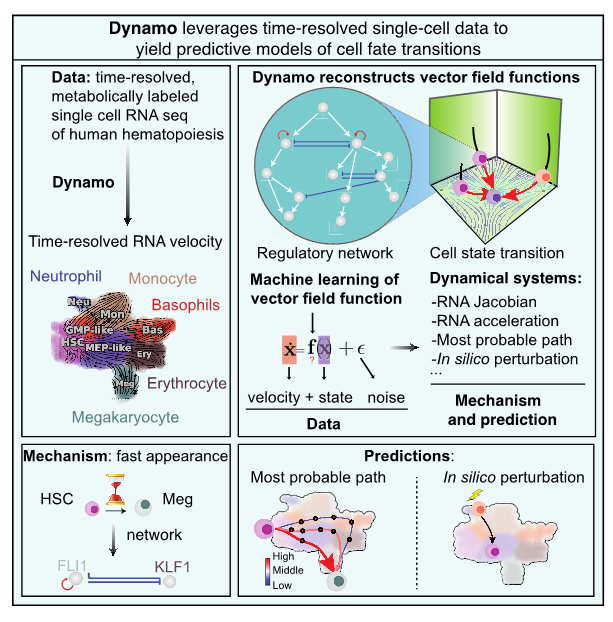
Yan Zhang |

Ivet Bahar |

Jianhua Xing |
Single-cell (sc)RNA-seq, together with RNA velocity and metabolic labeling, reveals cellular states and transitions at unprecedented resolution. Fully exploiting these data, however, requires kinetic models capable of unveiling governing regulatory functions. Here, we introduce an analytical framework dynamo (https://github.com/aristoteleo/dynamo-release), which infers absolute RNA velocity, reconstructs continuous vector fields that predict cell fates, employs differential geometry to extract underlying regulations, and ultimately predicts optimal reprogramming paths and perturbation outcomes. We highlight dynamo’s power to overcome fundamental limitations of conventional splicing-based RNA velocity analyses to enable accurate velocity estimations on a metabolically labeled human hematopoiesis scRNA-seq dataset. Furthermore, differential geometry analyses reveal mechanisms driving early megakaryocyte appearance and elucidate asymmetrical regulation within the PU.1-GATA1 circuit. Leveraging the least-action-path method, dynamo accurately predicts drivers of numerous hematopoietic transitions. Finally, in silico perturbations predict cell-fate diversions induced by gene perturbations. Dynamo, thus, represents an important step in advancing quantitative and predictive theories of cell-state transitions.

Figure 1. Overview of dynamo computational framework for analyzing time-resolved single-cell data.
Upper left: Dynamo generates time-resolved RNA velocity from metabolically labeled single cell RNA-seq data based on a biophysical model of gene expression.
Upper right: The transcriptomic vector field reconstructed from discrete RNA velocity samples using a machine learning method encodes essential gene-gene interaction information in the underlying gene regulatory network, which can be extracted from various differential geometrical quantities of the vector field.
Lower left: Dynamo reveals the underlying biological mechanism for the fast appearance of Megakaryocytes in a hematopoiesis dataset.
Lower right: Dynamo predicts cell type transitions by mapping out the most probable path and cell fate changes under in silico perturbations.
Whitehead Institute News Article
UPMC News
Qiu X, Zhang Y, Martin-Rufino JD, Weng C, Hosseinzadeh S, Yang D, Pogson AN, Hein MY, Min KH, Wang L, Grody EI, Shurtleff MJ, Yuan R, Xu S, Ma Y, Replogle JM. Lander ES, Darmanis S, Bahar I, Sankaran VG, Xing J, Weissman JS (2022) Mapping transcriptomic vector fields of single cells. Cell, in press.
